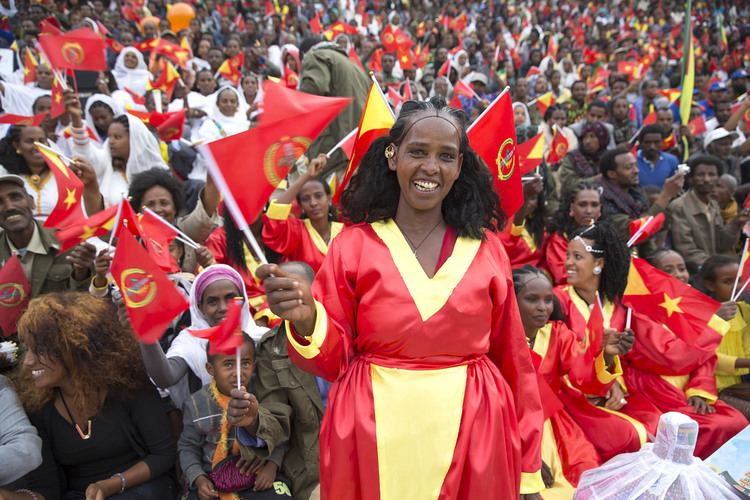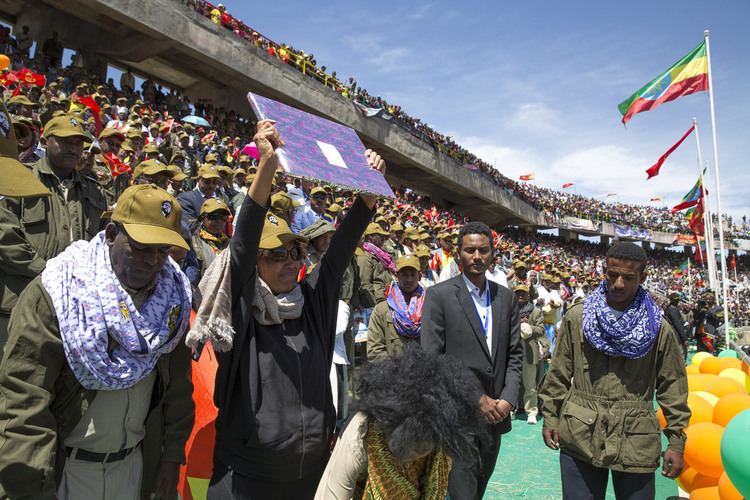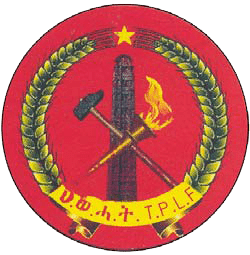Chairman Abay Weldu Newspaper Weyin (ወይን) | Founded 18 February 1975 | |
 | ||
Deputy Chairman Debretsion Gebremichael Headquarters Mekelle, Tigray Region, Ethiopia Ideology Marxism
Socialism
Tigrayan self-determination | ||
The Tigrayan People's Liberation Front (TPLF) (Ge'ez: ህወሓት), known more commonly and sometimes as Weyane or Second Weyane (Ge'ez: ወያነ/ ካልኣይ ወያነ) (Ge'ez: ህዝባዊ ወያነ ሓርነት ትግራይ, Tigrinya: ḥizbāwī weyānē ḥārinet tigrāy?, "Popular revolution (for) the freedom of Tigray") is a political party in Tigray, Ethiopia. At the last legislative elections, the party was the main part of the Ethiopian People's Revolutionary Democratic Front, that claimed 499 out of 547 seats.
Contents
- President kagame at 40th anniversary of the tigrayan people s liberation front mekelle ethiopia
- History
- Members
- References

In the August 2005 Regional assembly elections, the party claimed victory, winning all 152 seats in the Tigray Region.

TPLF is organized with a Central Committee and a politburo. Prior to its victory in the Ethiopian Civil War, TPLF was divided in four regional organization, three in Tigray and the fourth those who reside outside of Tigray. Each of the regions in Tigray had politburo members coordinating their activities. The foreign committee supervised subdivisions in Sudan, Middle East, Europe and North America.

President kagame at 40th anniversary of the tigrayan people s liberation front mekelle ethiopia
History

On 14 September 1974 a group of seven university students (Fantahun (Gidey) Zeratsion, Alemseged (Hailu) Mengesha, Berihu (Aregawi) Berehe, Zeri’u (Agazi) Gessesse, Mulugeta (Asfaha) Hagos, Ambay (Seyoum) Mesfin and Amaha (Abay) Tsehaye) in Addis Ababa formed the Tigrayan National Organization (Ge'ez: ማህበር ገስገስቲ ብሄረ ትግራይ, "Association of Progressives from Tigray Nation"). TNO formed clandestine cells and carried out propaganda work amongst the people. During the 1974 popular uprising, TNO played an important role in mobilizing the people of Tigray. After the takeover by the Derg junta, TNO claimed that armed struggle was necessary to remove the new regime. On 8 February 1975, the TNO was transformed into the TPLF (Tigrayan People's Liberation Front). The then newly formed front created the TPLF Manifesto in which it asserted its primary mission was to secede from the wider Ethiopian state, and create an independent Tigray state. The Tigray state map was extended from the Tekeze river in the Northwest to the Northeast of the Afar region. However, after much discussion, this mission was quickly abandoned and updated to exercise the right of Ethiopian people to self-determination. They soon established their first military base at Dedebit in Tigray, and began political and military preparations. The Eritrean People's Liberation Front assisted in the military preparations of the TPLF by providing them with the arms and other supplies. Throughout the Ethiopian Civil War, both groups were allied against the Derg.
At first, the TPLF was only one of several rebel groups in Tigray, and only one of their members had any military training. In his history of the TPLF, Aregawi Berhe readily admits that had it not been for the mentorship of Gessesew Ayele (better known by his nickname "Sehul"), a member of the Ethiopian parliament and respected local Tigrayan elder, the nascent TPLF would have come to quick disaster: Sehul had extensive personal contacts in western Tigray who provided support to the tiny group, as well as the power of personality to intimidate the local shiftas. The TPLF was able to establish their presence with a raid on the jail in Shire on the morning of 5 August 1975, in which they freed their captured comrade Mehari Tekle ("Mussie") and 60 other prisoners (including convicted criminals), then a month later on the afternoon of 4 September when they robbed the bank in Axum, in which four policemen were killed and 175,000 Birr (equivalent to US$84,000), and substantial arms and ammunition were stolen at the cost of one fighter wounded.
Rival anti-government groups in Tigray were the Ethiopian Democratic Union (EDU, led by Ras Mengesha Seyoum, commonly seen as a pro-monarchist group), the Tigray Liberation Front (TLF, led by Yohannes Tekle Haymanot who advocated Tigray independence just like the TPLF), and the Ethiopian People's Revolutionary Party (EPRP, moved to Mount Asimba in eastern Tigray after the Red Terror). According to Aregawi, the TPLF reached out to each of the other groups to form tactical alliances, only to be disappointed. The first rival group to be eliminated was the TLF, which split into three factions in November 1975; and after an investigation executed its two top leaders for "crimes against their own colleagues". Next was the EDU, whom Aregawi blames fired the first shot by killing Sehul. After fighting several pitched battles with the EDU (Chiameskebet on 26 September 1976, and Addi Nebreid in July 1976 and 12 March 1977) which were costly in men and materiel, the TPLF resorted to guerrilla warfare against the EDU, finally driving them out of western Tigray in the Battle of Quinat-Arbaete in November 1979. The EPRP was the last group engaged; although Aregawi claims that the EPRP fired the first shots, Gebru Tareke writes that it is impossible to determine which group actually did, noting "the parties have continued to argue the point." In any case, EPRP units allegedly attacked TPLF units in Agame on 23 February 1978, forcing them to evacuate the province. The TPLF brought two of its veteran companies from the west, and in a fierce counter-attack forced the EPRP fighters back to Mount Asimba. After a five-day battle, the TPLF captured their mountain stronghold, and the bulk of the defeated EPRP fled to sanctuary in Eritrean Liberation Front territory.
Around 1983, the core cadres of TPLF founded the Marxist–Leninist League of Tigray in the line of the Party of Labour of Albania. They also incorporated the name Woyane in the title of their organization as an intentional reference to the Woyane rebellion, a revolt in Tigray that arose and was crushed in 1943.
Following the success of the TPLF in 1991 in gaining control of Ethiopia, and the collapse of communist regime in Albania, the TPLF dropped all references to Marxism-Leninism. The leadership of the TPLF claims that the MLLT dissolved when the TPLF-backed Ethiopian People's Revolutionary Democratic Front took power after the collapse of the Derg in 1991.
Members
Members of the TPLF include: Seyoum Mesfin, Sebhat Nega, Arkebe Oqubay, Abay Tsehaye, Abadi Zemo, Tsegay Berhe, Azeb Mesfin, Haftom Abraha, and Weyen (deceased).
Prominent former members include: Meles Zenawi (party chairman), Seeye Abraha, Shewit Dagnew, Gebru Asrat, Atakilti Ketsela, Ghidey Zeratsion, Aregawi Berhe, Tewolde Wolde Mariam, Alemseged Gebreamlak, Hailu Mengesha, Aregash Adane, Awalom Woldu, Abebe Tessema and Kinfe Gebremedhin.
